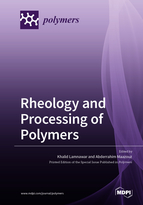Rheology and Processing of Polymers
A special issue of Polymers (ISSN 2073-4360). This special issue belongs to the section "Polymer Processing and Engineering".
Deadline for manuscript submissions: closed (25 February 2022) | Viewed by 44014
Special Issue Editors
Interests: rheology and flow; linear and nonlinear rheology; polymers and composites; polymer processing; multilayer; coextrusion; modeling; multiphase polymeric systems; biopolymers; biocomposites; composites
Special Issues, Collections and Topics in MDPI journals
Interests: viscoelasticity; rheology; rheology and process engineering of polymer materials, biopolymers and their composites; interfacial phenomena in the polymer and composites processing
Special Issues, Collections and Topics in MDPI journals
Special Issue Information
Dear Colleagues,
We are delighted to invite you to submit a manuscript for a Special Issue of Polymers (impact factor of 3.164 and ranking 17/87 (Q1) in polymer science, https://0-www-mdpi-com.brum.beds.ac.uk/journal/polymers)) entitled "Rheology and Processing of Polymers”.
This Special Issue will cover the latest developments in the field of rheology and polymer processing, highlight cutting-edge research focusing on the processing of advanced polymers and their composites. It will demonstrate that the field of “Rheology and Polymer Processing” is still gaining increased attention. This Special Issue promises to maintain a good balance of papers to serve the attendees from academia and industry. It will provide cutting-edge research results and the latest developments in the field of polymer science and engineering, their innovative processing, biopolymers, and characterization, polymer-based products, polymer physics, composites, modeling and simulations, and rheology. Ideally, contributions should focus on fundamental and experimental results in a thematic range that comprises conventional processing technologies as well as innovative processing and materials-based macromolecular research. The issue will compile the current state-of-the-art and highlight the range of applications. Both original contributions and reviews are welcome.
Prof. khalid Lamnawar
Prof. Abderrahim Maazouz
Guest Editors
Manuscript Submission Information
Manuscripts should be submitted online at www.mdpi.com by registering and logging in to this website. Once you are registered, click here to go to the submission form. Manuscripts can be submitted until the deadline. All submissions that pass pre-check are peer-reviewed. Accepted papers will be published continuously in the journal (as soon as accepted) and will be listed together on the special issue website. Research articles, review articles as well as short communications are invited. For planned papers, a title and short abstract (about 100 words) can be sent to the Editorial Office for announcement on this website.
Submitted manuscripts should not have been published previously, nor be under consideration for publication elsewhere (except conference proceedings papers). All manuscripts are thoroughly refereed through a single-blind peer-review process. A guide for authors and other relevant information for submission of manuscripts is available on the Instructions for Authors page. Polymers is an international peer-reviewed open access semimonthly journal published by MDPI.
Please visit the Instructions for Authors page before submitting a manuscript. The Article Processing Charge (APC) for publication in this open access journal is 2700 CHF (Swiss Francs). Submitted papers should be well formatted and use good English. Authors may use MDPI's English editing service prior to publication or during author revisions.
Keywords
- Polymer processing
- Rheology
- Polymers
- Natural polymers and biopolymers
- Biopolymers
- Polymer nanocomposites
- Advanced polymers
- Composites
- Biocomposites
- Modeling
- Numerical simulation
- Polymer physics
- Innovative processing
- Polymer melts
- Polymer engineering








